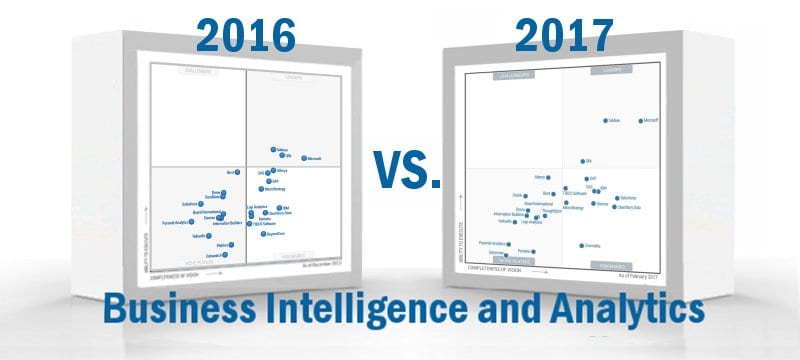What’s Changed: 2017 Gartner Magic Quadrant for Business Intelligence and Analytics Platforms


Analyst house Gartner has officially released the 2017 version of their Magic Quadrant for Business Intelligence and Analytics Platforms. IT-led reporting platforms are a thing of the past, with modern tools now accounting for the vast majority of available software solutions in the marketplace. As a result, stakeholders have a wealth of tools from which to choose, with traditional vendors who have upgraded their platforms on one side, and the emerging disruptors on the other. Gartner explains: “The crowded BI and analytics market includes everything from longtime, large technology players to startups backed by enormous amounts of venture capital.”
Gartner has been warning of the coming evolution in BI and analytics for some time, and in 2016 redesigned the popular report to more adequately represent the changeover. The Magic Quadrant provides ample evidence to suggest that agile BI is now the industry standard. This software sector is mature and saturated with intriguing options for buyers looking to expand their use of self-service BI. Providers included in this year’s report are assessed based on their support of five main critical capabilities (use cases):
- Agile centralized BI provisioning
- Decentralized analytics
- Governed data discovery
- OEM or embedded BI
- Extranet deployment
Oracle makes a triumphant return to the report after being left out in 2016. In addition, ThoughtSpot, Datameer, and Zoomdata also make an appearance. Platfora was acquired by Workday and is no longer sold as a standalone solution, and as such, has been axed. BeyondCore was acquired by Salesforce and is also no longer included. In addition, Datawatch and GoodData were excluded for no longer meeting Gartner’s inclusion criteria.
The 2017 Magic Quadrant features a lot of vendor movement, with many of the most prominent solution providers having their standing downgraded as they attempt to keep their head above water. With the exception of Tableau and Microsoft, who saw their positioning improve drastically among the market leaders, the household names have their work cut out for them if they wish to see improved standing in next year’s coverage. Alteryx, Logi Analytics, MicroStrategy and Pentaho all suffered major downgrades in standing.
Notable gainers include the likes of Sisense and Salesforce, whom now occupy spots among the market visionaries after spending 2016 as niche players, and TIBCO Software, a provider that has an upgraded position in their own sphere of influence. The placement of solution providers in this report speaks to the fact that traditional BI vendors have had a tough time adapting to the new landscape, with Gartner saying: “What is new this year, is that traditional BI vendors that were slow to adjust to the “modern wave of disruption struggled to remain relevant during the market transition.
If your organization is one of the many looking to adopt a modern data analytics tool, read how about how team organization can play a vital role in deployment.
Learn how to organize your team for modern analytics deployment.




































